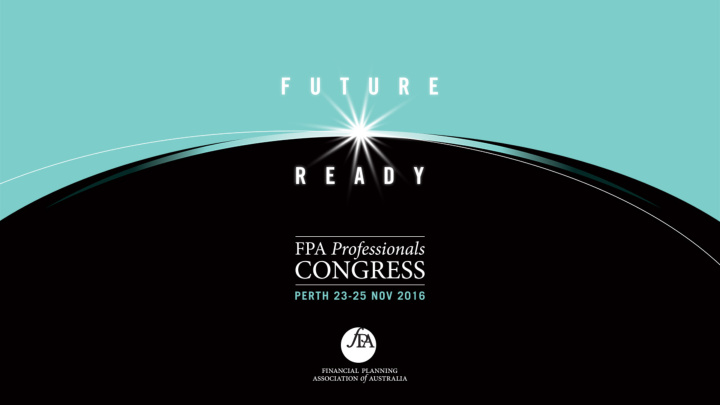



TAX EFFECTIVE ESTATE PLANNING Scott Hay-Bartlem Partner, Cooper Grace Ward
CONTENTS Case Study Family trusts v testamentary trusts in estate planning SMSFs, 2016 Budget announcements and estate planning
CASE STUDY Charles and Camilla • Charles – late 60s, 2 children • William, mid 30s, professional, 2 young children, non-working spouse • Harry, early 30s, wild, no children • Camilla – late 60s, 2 children • Tom, early 40s, author and TV, married, 1 child • Laura, 30s, arty, married, 1 child
FAMILY TRUST V TESTAMENTARY TRUST Family Testamentary • Set up deliberately while alive • Set up under Will • Separate trust deed • Terms are part of Will • Assets transferred/gifted/loaned • Assets gifted under Will in • Typically narrow blood • Wide range of beneficiaries descendant beneficiaries • Very flexible • Tend to be less flexible • Rarely tailored • Usually tailored as part of estate planning • Not part of estate (control) • Assets have to get though estate first
FAMILY TRUST V TESTAMENTARY TRUST Family Testamentary •Income taxed to recipient •Income taxed to recipient at marginal tax rate at marginal tax rate •Under 18s taxed at top •Under 18s taxed at normal marginal rate adult tax rates •Assets transferred to •Assets transferred to beneficiaries triggers CGT beneficiaries usually does event and often duty not trigger CGT event and may not attract duty
UNDER 18 BENEFICIARIES Income from trusts usually taxed at top marginal rate • Earnings from assets inherited as a result of death ‘excepted trust income’ • Taxed to the beneficiary at normal adult tax rates No magic in how the trust was established Gift in Will to existing family trust • Track? can give rise to ‘excepted trust • Mix/keep separate income’ • Tidier in a separate trust
OTHER BENEFITS OF TRUSTS No ownership/entitlement Bankruptcy/creditors Control from the grave Not part of estate – Limit control estate challenges Potentially matrimonial
WHEN USE TESTAMENTARY TRUSTS? Spouses with risk issues Children with risk issues Don’t like the in-laws… Protect from estate claims down the line Under 18 potential beneficiaries – children/grandchildren/further Life interests Limit access to assets Limit control Control from the grave Foundations/charities/family legacies
CASE STUDY Charles’ estate Should he use planning testamentary trusts?
SO WHAT IF I HAVE A FAMILY TRUST? Assets not part of an estate so Any amount owed to me is an does not go into a estate asset testamentary trust when I die So any amounts owed from the family trust to me • Estate asset • Gifted to testamentary trust • Can pull assets through from family trust to testamentary trust • Could charge interest
CASE STUDY Charles’ assets predominantly in a family trust Wants to divide estate between Camilla (40%) and William and Harry (30% each) No fixed entitlement from family trust
CASE STUDY Memo of wishes Independent Share controller control
CASE STUDY If Charles is owed money from the Create debt through capital family trust distribution? • Pass that through estate to • Revalue assets? beneficiary • Interim capital distribution • Testamentary trusts for • Rules for payment William/Harry? • Some traps – requires care! • Rules for payment • Camilla gets control of family trust • Under Will? • Hardwire? • Shares in trustee company as joint tenants?
LOAN V GIFT TO FAMILY TRUST So every time money goes into a family trust, estate planning decision Consequences of loaning v gifting quite fundamental •Asset belongs to lender – creditors/estate •Asset is gone! Can mess up the best planning •Remember Clark v Inglis
QUESTIONS? ?
2016 BUDGET, SMSFS AND ESTATE PLANNING Legislation Want passed by Effective 1 July before 1 December 2017 Parliament 2017
2016 BUDGET, SMSFS AND ESTATE PLANNING What has not changed • Must pay the death benefit • Trustee discretion • Potential recipients • Who can receive a death benefit pension • How BDBNs work
2016 BUDGET, SMSFS AND ESTATE PLANNING Some • $1.6m transfer balance cap for pensions • Members move funds back into accumulation accounts important • Death benefit pension counts to recipient’s TBC • Death benefits can be rolled over changes • Special TBC rules for child pensions • Reversionary pension strategies must be reviewed • Paying a death benefit pension counts to recipients TBC This means… • Even if auto-reversionary • Has spouse used theirs? • 12 months to sort out reversionary
2016 BUDGET, SMSFS AND ESTATE PLANNING We need to think about • Child pensions • Which pension goes? • Death benefit must still be paid, so if not as pension then lump sum • Maybe commute recipient’s own pension back so it can stay in the super system • Deal with reversionary pensions within 12 months of death • Is the pension ‘reversionary’?
CASE STUDY Charles and Camilla each have $1.2m in a pension •Camilla dies •If pension moves to Charles, he is over his TBC •$1.2m already •$1.2m from Camilla
CASE STUDY Charles and Camilla each have Options $1.2m in a pension • Camilla dies • Take Camilla’s benefit • If pension moves to Charles, • $400,000 pension he is over his TBC • $800,000 lump sum • $1.2m already • Commute part of his pension • $1.2m from Camilla back to accumulation and Camilla’s benefit as pension • A combination • If reversionary, 12 months
2016 BUDGET, SMSFS AND ESTATE PLANNING Child pensions • Under 18, or under 25 and dependant, or disabled • Separate TBC, but still limits • Must commute at 25, so maybe not whole interest • Spend funds for their benefit, so surviving parent still benefits • Do existing BDBNs/reversions mean we cannot – don’t limit?
2016 BUDGET, SMSFS AND ESTATE PLANNING Once legislation is through, must review planning! Beware decisions now that lock in decisions too much!
QUESTIONS? ?
Recommend
More recommend